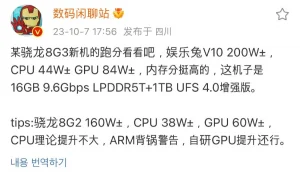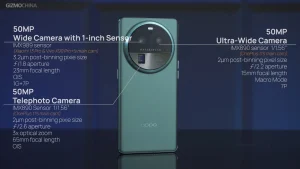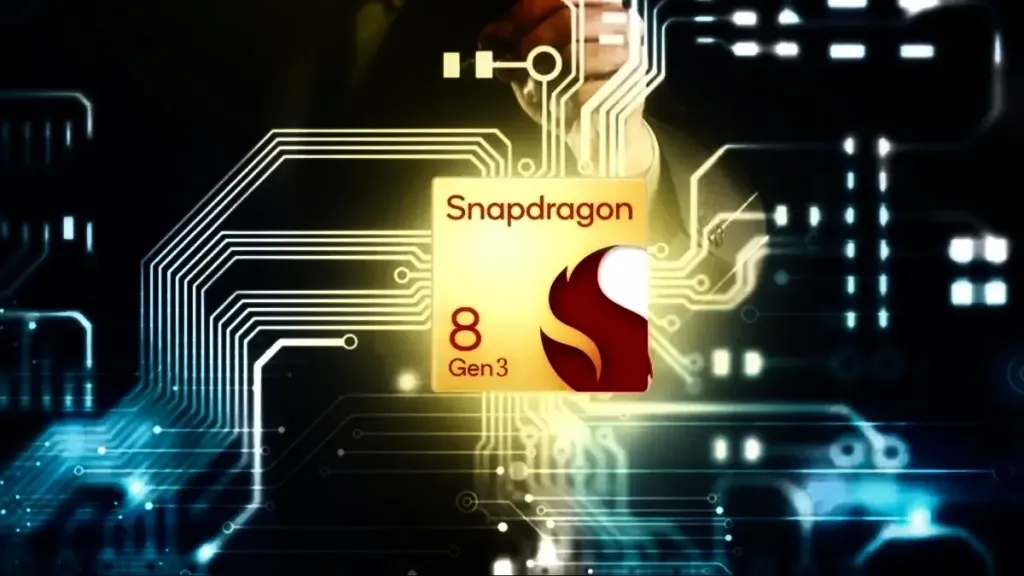Qualcomm is about to announce a new, more powerful mobile chip called the Snapdragon 8 Gen 3. Before its release, there’s information saying this new chip is much better than the older one, the Snapdragon 8 Gen 2.
How do we know? A trusted source shared test results. The new chip scored 2 million points on a test, while the older one scored 1.6 million. So, the new chip seems to be a big improvement

The new Snapdragon 8 Gen 3 processor offers a significant boost in graphics performance. In a test called AnTuTu GPU, it scored 840,000 points, which is a 40% improvement compared to the previous Snapdragon 8 Gen 2 that scored 600,000 points.
This is great news for mobile gamers as it means that upcoming flagship smartphones with this processor will deliver even better gaming performance.
However, when it comes to the processor’s overall computing power (CPU performance), it showed less improvement. In the same test, it scored 440,000 points, which is only about 15.7% higher than the previous Snapdragon 8 Gen 2.

These early performance tests for the Snapdragon 8 Gen 3 should be taken with a grain of caution, as the final performance of this processor may differ.
It’s important to note that the tested Snapdragon 8 Gen 3 in these benchmarks used LPDDR5T RAM, which is faster and more efficient compared to LPDDR5X RAM.
The type of RAM used in commercial smartphones with Snapdragon 8 Gen 3 is still uncertain. If these smartphones end up using LPDDR5X RAM, the real-world performance might be a bit lower than what’s seen in the benchmarks.
In summary, while these initial benchmarks look promising, we can’t be entirely certain about how much better the Snapdragon 8 Gen 3 will perform compared to the Snapdragon 8 Gen 2 until it’s officially announced by Qualcomm on October 24th.
It More About
Qualcomm’s New Snapdragon 7s Gen 2 Processor is a Secret Rebrand of Last Year’s Snapdragon 6 Gen 1
 Qualcomm’s Naming Scheme Gone Confusing (Visualised) (Leo Wong De Quan/Gizmochina)
Qualcomm’s Naming Scheme Gone Confusing (Visualised) (Leo Wong De Quan/Gizmochina)In the lowest category, Tier D, there are a total of 6 Snapdragon processors that have received a poor rating. These processors share common features, such as having a 2+6 CPU structure.
This means they consist of 2 high-performance CPU cores and 6 efficiency CPU cores to handle smartphone tasks. One interesting commonality among these processors is that they are all manufactured using Samsung’s production technology.
This technology is known for being less efficient in terms of battery life compared to TSMC’s technology due to lower yields and power efficiency.
As a result, processors like the Snapdragon 4 Gen 2 in 2023 may perform worse than processors like the MediaTek Dimensity 810 and Dimensity 800U, which have been used in smartphones released over three years ago.
| Snapdragon Chip | High Performance CPU Cores | Efficiency CPU Cores | GPU | Node Process | Antutu Score |
| Snapdragon 480, 480+ | 2x ARM Cortex A76 | 6x ARM Cortex A55 | Adreno 619 | Samsung 8nm | 350,035 |
| Snapdragon 765, 765G, 768G | 2x ARM Cortex A76 | 6x ARM Cortex A55 | Adreno 620 | Samsung 7nm | 385,681 |
| Snapdragon 690 | 2x ARM Cortex A77 | 6x ARM Cortex A55 | Adreno 619L | Samsung 8nm | 361,536 |
| Snapdragon 750G | 2x ARM Cortex A77 | 6x ARM Cortex A55 | Adreno 619 | Samsung 8nm | 438,295 |
| Snapdragon 4 Gen 1, Snapdragon 695 | 2x ARM Cortex A78 | 6x ARM Cortex A55 | Adreno 619 | TSMC 6nm | 435,422 |
| Snapdragon 4 Gen 2 | 2x ARM Cortex A78 | 6x ARM Cortex A55 | Adreno 613 | Samsung 4nm | 425,064 |
Table 1: Snapdragon Processors in Tier D (Source: Leo Wong De Quan / Gizmochina)

In Tier C, there’s a notable similarity among the Snapdragon processors listed: they are all manufactured using Samsung’s process technology. The only exception in this category is the Snapdragon 778G, which is produced using TSMC’s 6nm process.
The Snapdragon processors in Tier C have faced criticism, particularly the Snapdragon 888 and 8 Gen 1, for causing overheating issues and thermal throttling in smartphones.
Users have expressed frustration about spending money on expensive Android devices only to experience excessive heat during prolonged smartphone usage.
In some cases, the excessive heat has even caused damage to the smartphone’s motherboard, resulting in costly repairs.

These Tier C processors typically feature a 4+4 CPU structure, meaning they have 4 high-performance CPU cores and 4 efficiency CPU cores. Among the processors in this tier, the Snapdragon 778G series is quite popular.
This is because it’s the only processor in Tier C manufactured on TSMC’s 6nm process, which helps avoid the higher temperatures and power consumption observed in its counterparts made using Samsung’s technology.
However, for mid-range chips, the difference in power consumption is usually minimal, and the main factor affecting performance is the quality of the GPU.
The Snapdragon 778G’s reputation for power efficiency makes it an attractive choice for smartphone manufacturers. In 2023, you can find this processor in a variety of devices, from older models like the Samsung Galaxy A52s 5G (2021) to newer releases such as the Poco X5 Pro (2023) and Oppo Reno 10 Pro (2023).
Tier B: Good Rating
In Tier B, we find only one Snapdragon processor, the Snapdragon 865 series. This processor can be found in smartphones like the Samsung Galaxy S20 FE 5G, OnePlus 8 Pro, Poco F3, and Xiaomi Mi 11X.
| Snapdragon Chip | High Performance CPU Cores | Efficiency CPU Cores | GPU | Node Process | Antutu Score |
| Snapdragon 865, 865+, 870 | 4x ARM Cortex A77 | 4x ARM Cortex A55 | Adreno 650 | TSMC 7nm | 801,876 |
Table 3: Snapdragon Processors in Tier B (Source: Leo Wong De Quan / Gizmochina)
One of its advantages over newer Snapdragon processors, like the Snapdragon 888 and 8 Gen 1, is that it operates at a much lower temperature.
This is because it’s manufactured using TSMC’s 7nm process, which offers improved power efficiency and better battery life for smartphones powered by this chipset.

However, in 2023, the Snapdragon 865 from 2020 is starting to show its age when compared to newer solutions from MediaTek.
such as the Dimensity 8000 and 9000 series of 5G smartphone processors. Nevertheless, the fact that this processor remains highly competitive in the market after three years highlights its value.
Its performance is expected to remain smooth and reliable until at least 2025.
Tier A: Excellent Rating
Finally, in Tier A, we have the best of the best when it comes to Snapdragon processors in 2023. There are three of these top-tier processors, and they are detailed in Table 4 below.
These Tier A Snapdragon processors make use of TSMC’s cutting-edge 4nm manufacturing process. They stand out as some of the finest processors you can find in an Android smartphone for 2023.
| Snapdragon Chip | High Performance CPU Cores | Efficiency CPU Cores | GPU | Node Process | Antutu Score |
| Snapdragon 7+ Gen 2 | 1x ARM Cortex X2, 3x Cortex A710 | 4x ARM Cortex A510 | Adreno 725 | TSMC 4nm | 1,109,000 |
| Snapdragon 8+ Gen 1 | 1x ARM Cortex X2, 3x Cortex A710 | 4x ARM Cortex A510 | Adreno 730 | TSMC 4nm | 1,266,919 |
| Snapdragon 8 Gen 2, 8 Gen 2 for Galaxy | 1x ARM Cortex X3, 2x Cortex A715, 2x Cortex A710 | 3x ARM Cortex A510 | Adreno 740 | TSMC 4nm | 1,493,565 |
They strike a remarkable balance between power efficiency and high performance, leaving processors from Tiers B, C, and D far behind.
If you own a smartphone equipped with a Tier A processor, you can expect fast and seamless performance well into 2028, or perhaps even longer.

Examples of smartphones that feature Tier A processors include the Redmi Note 12 Turbo (also known as the Poco F5), the Samsung Galaxy S23 series, the Xiaomi 13 series, and the Oppo Find X6 Pro.

